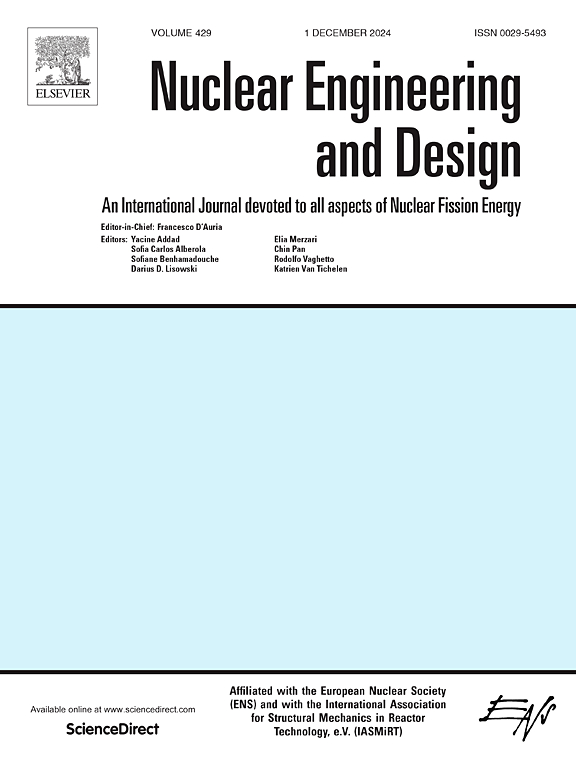用于总堵塞和瞬时堵塞检测的核棒温度自适应统计模型
IF 2.1
3区 工程技术
Q1 NUCLEAR SCIENCE & TECHNOLOGY
引用次数: 0
摘要
对关键系统的监控至关重要,尤其是在未被发现的故障可能导致重大事故的情况下。本文主要研究核电站内燃料棒组件的温度监测,目的是尽可能可靠、快速地检测出总堵塞和瞬时堵塞。首先,我们对整个燃料棒组件的温度进行建模。我们提出了一个自适应的线性参数模型,结合以前的温度测量来提高其准确性。这种方法使我们能够区分正常的、非异常的温度和由堵塞引起的异常热事件。由于虚警率和检测功率是解析有界的,因此所提出的顺序或在线检测方案是可靠的。模型和随后的统计检验是通用的,使该方法适用于广泛的核芯。利用superphacimnix电站的实际温度测量数据进行了数值实验,验证了所提出模型的准确性和检测程序的相关性。本文章由计算机程序翻译,如有差异,请以英文原文为准。
An adaptive statistical model of nuclear rods temperature for the detection of total and instantaneous blockage
The monitoring of critical systems is of the utmost importance, especially when undetected malfunctions could lead to major accidents. This paper focuses on the temperature monitoring of fuel rod assemblies within nuclear power plants, with the goal of detecting total and instantaneous blockages as reliably and quickly as possible. First, we address the modelling of the temperature of the whole fuel rod assembly altogether. We propose a linear parametric model that is adaptive, incorporating previous temperature measurements to enhance its accuracy. This approach allows us to distinguish between regular, non-anomalous temperatures and the anomalous thermal event due to a blockage. The proposed sequential, or online, detection scheme is reliable, as the false alarm rate and detection power are analytically bounded. The model and subsequent statistical test are generic, making the methodology applicable to a wide range of nuclear cores. Numerical experiments, using real temperature measurements from the Superphénix power station, demonstrate the accuracy of the proposed model and the relevance of the detection procedure.
求助全文
通过发布文献求助,成功后即可免费获取论文全文。
去求助
来源期刊

Nuclear Engineering and Design
工程技术-核科学技术
CiteScore
3.40
自引率
11.80%
发文量
377
审稿时长
5 months
期刊介绍:
Nuclear Engineering and Design covers the wide range of disciplines involved in the engineering, design, safety and construction of nuclear fission reactors. The Editors welcome papers both on applied and innovative aspects and developments in nuclear science and technology.
Fundamentals of Reactor Design include:
• Thermal-Hydraulics and Core Physics
• Safety Analysis, Risk Assessment (PSA)
• Structural and Mechanical Engineering
• Materials Science
• Fuel Behavior and Design
• Structural Plant Design
• Engineering of Reactor Components
• Experiments
Aspects beyond fundamentals of Reactor Design covered:
• Accident Mitigation Measures
• Reactor Control Systems
• Licensing Issues
• Safeguard Engineering
• Economy of Plants
• Reprocessing / Waste Disposal
• Applications of Nuclear Energy
• Maintenance
• Decommissioning
Papers on new reactor ideas and developments (Generation IV reactors) such as inherently safe modular HTRs, High Performance LWRs/HWRs and LMFBs/GFR will be considered; Actinide Burners, Accelerator Driven Systems, Energy Amplifiers and other special designs of power and research reactors and their applications are also encouraged.
 求助内容:
求助内容: 应助结果提醒方式:
应助结果提醒方式:


